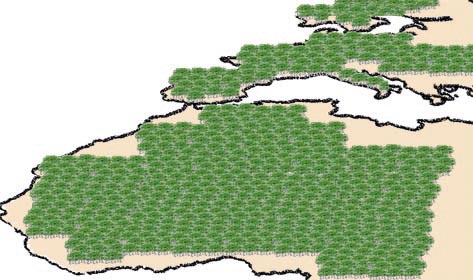Afforestation

Reforestation has long been standard forestry practice. It is generally done for timber production or to return cleared forest land to its natural state. Forests have also been planted in recent years to compensate CO2 emissions. Trees store atmospheric CO2 in wood by photosynthesis. Depending on their longevity, the carbon can remain sequestered in them for several centuries. Ideally, their timber should subsequently be used in a way such that the carbon stays captured – for example in the construction of buildings. When wood is burned, the carbon is released again as CO2. Afforestation is spoken of as a CDR method when it is deliberately used on a sufficiently large scale to contribute significantly to removing CO2 from the atmosphere.
The idea of greening the Sahara and other large deserts goes as far back as the 1970s. However, studies show that the disadvantages outweigh the benefits. Not least, large quantities of water would have to be provided to cultivate the trees. The irrigation would probably cost more than other measures to reduce CO2 emissions and would drastically exacerbate regional water shortages. Another long-discussed proposal is the afforestation of northern tundra regions. However, that, too, could have negative consequences by decreasing the albedo effect, meaning the ability of the Earth’s surface to reflect solar radiation. Today’s tundra is covered in winter with ice and snow. This white surface reflects part of the solar radiation reaching the Earth back into space. By contrast, forests appear darker in winter and they consequently absorb more radiation as heat. A reduction in albedo would conflict with the aim of reforesting the tundra – preventing the Earth from heating up – and would thus be counterproductive.
Massive afforestation in middle and lower latitudes would also increase water exchange with the atmosphere. The leaf surfaces of trees transpire water, which then evaporates. As with an oasis, the ambient air cools as a result. The heat of condensation is released again when precipitation forms elsewhere. The additional water vapour can also affect cloud formation and the radiation balance. Depending on the region, therefore, afforestation can have contradictory local and global effects and, in part, can run contrary to the actual objective of preventing the Earth from heating up.
Potential and scale
By optimistic estimates, large-scale afforestation could capture large quantities of carbon worldwide. Potentially up to ten billion tonnes of CO2 per year could be sequestered in trees by 2100. This would involve planting at least eight million square kilometres of land on which other land uses have to be abandoned. That is roughly the area of Brazil. Afforestation could thus partially contribute to efforts for removing CO2 from the atmosphere that are needed alongside drastic emission reductions. If even larger areas were to be afforested, this CDR measure would conflict with other land uses such as pasture or the cultivation of energy or food crops. It is thus estimated that hardly any land will be available for future afforestation projects due to global population growth and the expansion of agriculture.
Application readiness and research needs
Experts have studied the pros and cons of large-scale afforestation closely in recent years. Scientists use mathematical models to try and determine the actual carbon dioxide removal potential of afforestation and the expected consequences for human life and the environment. Increasingly detailed studies also aim to determine, for example, what natural emissions are released from the soil during afforestation, what impacts it has on the radiation and hydrological regime, and what the costs of forest management are. Researchers are also investigating energy-saving and low-emission irrigation and fertilisation methods together with sustainable cultivation strategies that consider ecological and socioeconomic aspects. However, global population growth and the expansion of food production remain unknown, making it hard to accurately assess the potential.
